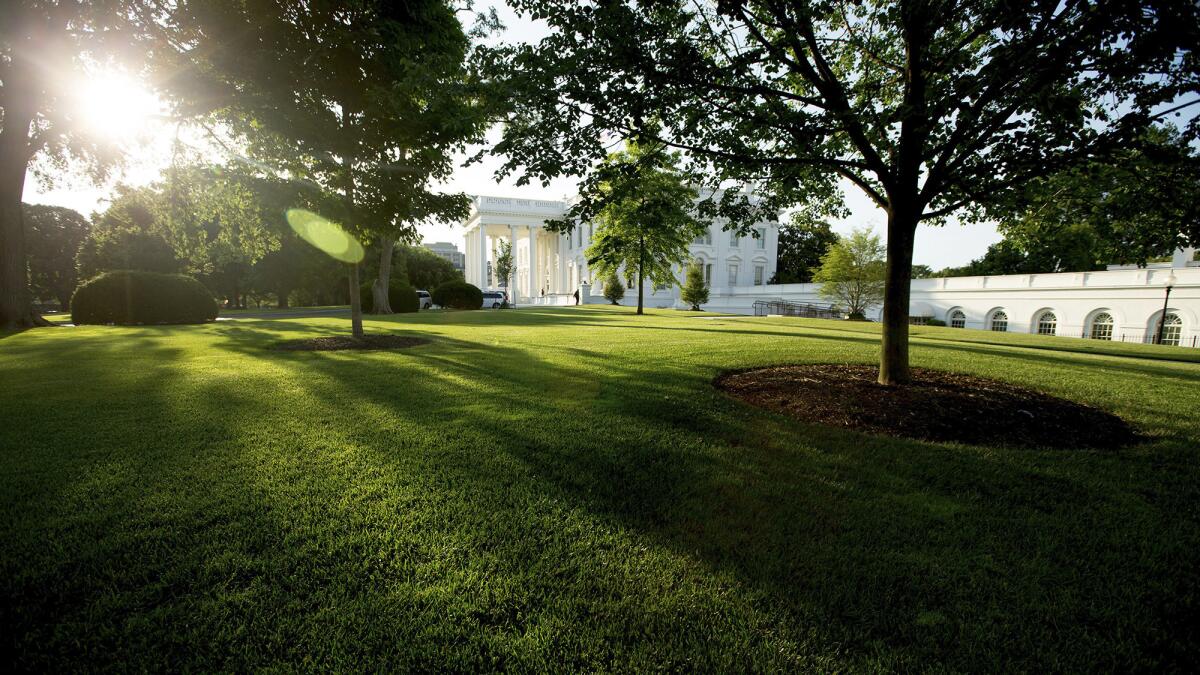How much would it cost to buy the White House?

- Share via
Washington, D.C., is full of famous, difficult-to-value properties left off the tax rolls. What about the most famous of them all?
Just for fun, one association set out to find out how much the White House would bring on the open property market.
“Valuing such a complex, iconic property is highly subjective, so we thought it would be interesting to try to put on number on that,” said Neil Shah, the Americas managing director for the Royal Institution of Chartered Surveyors of London.
The 150-year-old institution, or RICS, as it is commonly referred to, accredits real estate professionals in the land, property and construction sectors.
The fact that this is an election year and that one of the candidates is a real estate mogul made the White House project timely, Shah said.
The group’s total number included an estimate of the value of the White House’s contents, including artwork and an impressive collection of china.
“It is quite the goofy concept,” admits Barden Prisant, president of International Art Advisors in New York, who has helped put a number on the Statue of Liberty and who took part in the estimation of the U.S. landmark at 1600 Pennsylvania Ave.
Prisant and Ann Gray, a real estate consultant from Los Angeles, took on the assignment for RICS. The professionals arrived at an estimation of value for the White House and its 132 rooms, 18 acres of land and some 750 artifacts at $250 million.
The duo used the three standard methods of appraising anything of value: cost, income and comparables.
Gray said she arrived at a $90-million value for the White House and its land by comparing it with the construction costs of the Smithsonian Institution’s National Museum of African American History & Culture nearby. She tried to measure the White House income potential by analyzing it against the Jefferson, a high-end hotel up the street.
She put the value of the 18 acres the residence rests on at zero because the property, technically owned by the Interior Department, has no zoning. It has so many rules and regulations governing it, and so little vacant land nearby to compare it with, that it is difficult to measure.
Any developer ambitious enough to try and build a hotel, mall or office building on it would eat up any value the land had to begin with.
“This one is so over the top, by the time you got [development] rights you’d have spent what it’s worth on legal and lobbying fees,” she said.
Gray said her analysis involved all kinds of brain twisters, including comparing the White House with 10 Downing St., the home of U.K.’s prime minister. The prime minister’s house is easier to value because it is one in a series of similar row houses.
She even stumbled across Donald Trump’s Mar-A-Lago Club in Florida, which was donated to the United States by heiress Marjorie Merriweather Post as a presidential and diplomatic retreat. The U.S. government didn’t want it and deeded it back to the Post family in 1980; Trump bought it in 1985.
“It has tunnels, fallout shelters and a full package of sports amenities, tennis courts, swimming pool,” just like the White House, Gray said.
Prisant’s research, meanwhile, included the 750 items and works of art contained across the White House’s six floors and 55,000 square feet.
“Most intriguing is that a number of the most valuable items are not Americana at all,” Prisant said. “The most valuable paintings are French Impressionists and Post-Impressionists.”
Prisant said he believes the most valuable paintings are five works of art by Paul Cezanne, bequeathed to the White House by American art historian and collector Charles Loeser. He values them at $72.5 million.
He also used comparables as a way to value the White House contents. For example, a dinner plate from the Thomas Jefferson administration sold on the market for $25,000. He used that to put a value on the thousands of other pieces of china remaining.
Heath writes for the Washington Post.
Sign up for Essential California
The most important California stories and recommendations in your inbox every morning.
You may occasionally receive promotional content from the Los Angeles Times.



